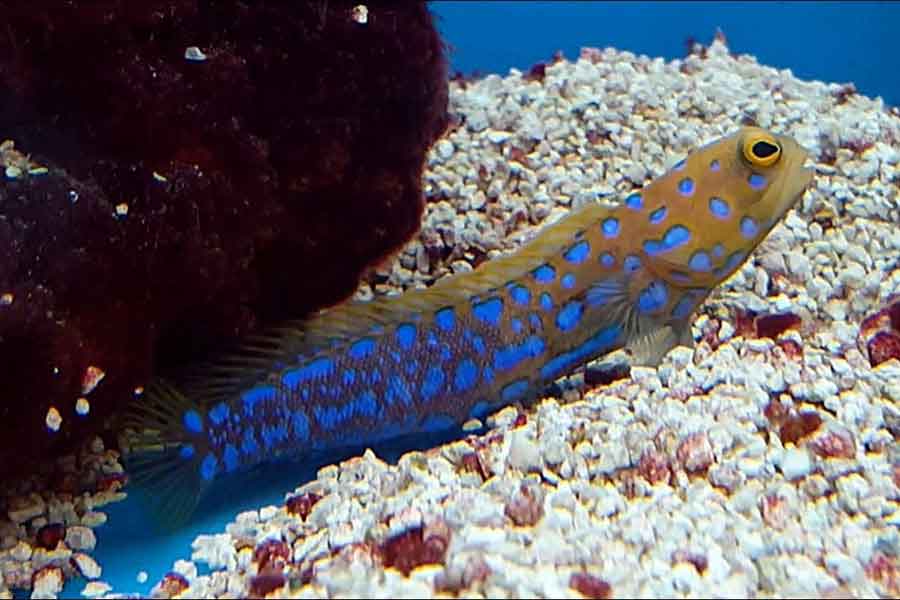
The yellowhead jawfish is a common inhabitant of sandy bottoms near coral reefs. It is often seen standing upright at the entrance of a small cave that it digs in the sandy substrate. At the slightest threat, it retreats into the cave tail-first, leaving only its head exposed or completely submerging itself.
Sometimes, you can observe a male, like the one in the photo, carrying a complete batch of eggs in its mouth, which it is incubating. This small fish, measuring no more than 10 cm in length, is often mistaken by divers for a goby when it is actually a blenny scientifically known as Opistognathus aurifrons. Very little is known about the life and reproduction of these blennies.
On one occasion, near Bimini Island in the Bahamas, I had the opportunity to encounter a particularly trusting jawfish. As I approached, it would retreat a few centimeters into its hole, only to come back out and look at me. After gaining its trust, the fish allowed me to approach very close to its refuge. Taking advantage of a distraction, I managed to block the hole with my finger before it could retreat. The fish hesitated for a couple of seconds and then darted off in a defined direction along the seafloor. Ten meters away, another blenny was at the entrance of its own cave, and upon seeing its neighbor pursued by a diver, it immediately hid. To my surprise, the jawfish I was chasing also entered the same hole.
I returned to the original hole that I had blocked with my finger and, using a small wire, determined that it was about 30 cm long. Why would the jawfish dig a refuge three times its size? This question may have several answers. Perhaps it is a simple cooperative sense of providing shelter to a neighbor in trouble. It is also possible that it serves as a defense mechanism, as any predator attempting to capture it would have to dig through twenty centimeters of sand.
Or perhaps it is directly related to the reproduction of these fish. If so, we could speculate that during the breeding season, the male receives visits from a female in his hole. The male enters the hole, releasing sperm. The female follows, also entering tail-first, releasing the eggs that are fertilized by the sperm inside the hole, away from predators. Since the eggs are heavier than water, they sink to the bottom, where the male simply waits with his mouth open. Once the eggs are laid, the female departs, and the male remains in charge of the eggs, periodically leaving the entrance of the refuge to ventilate them and provide clean water, but hiding with them at the slightest threat. While this is simply a personal theory, it seems logical to me because I cannot explain how the male could collect the eggs left by the female on the bottom without losing the ones already in its mouth.
As the male incubates the small eggs, two black spots appear on the sides of its head, perhaps a signal to other females that it already has a batch of eggs and they should seek new refuges. After a few days, the tiny fry will hatch and roam the seabed. Three days after birth, they will dig their own nearby caves close to the territory occupied by their parents. The mysteries of the sea are often numerous, complex, and almost always, the answer to one question brings forth a considerable number of new questions. Perhaps that is what makes it so fascinating.
«One cannot defend what one does not love, and one cannot love what one does not know.»

